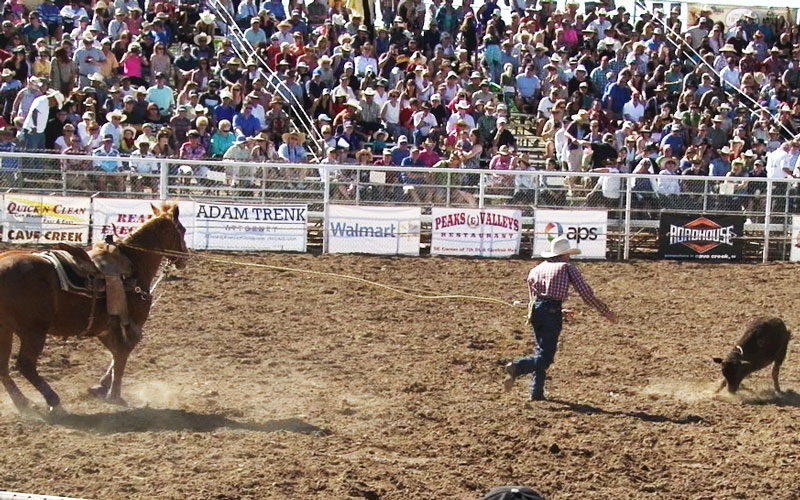
A cowboy races to the calf after roping it to tie three legs together. (Photo by Jessica Watts/Cronkite News)
CAVE CREEK – A calf breaks from the chute, and is dragged down in a cowboy’s lariat.
Read more:
Rodeo’s tradition rides on, growing in Arizona and the West
Coolidge junior college a breeding ground for rodeo success
Charrería, Mexico’s oldest sport, is young and alive in the United States
Payson, Prescott hold different ‘world’s oldest rodeo’ distinctions
Rodeo safety: ‘It’s not if you get hurt. It’s when and how bad’
A steer wrestler slides from his horse at full gallop, grabs a steer by the horns and wrenches it onto its back.
A bull leaps from the chute determined to shake a rider who is just as determined to stay aboard for eight seconds.
At first glance, rodeo events such as calf roping, steer wrestling and bull riding might look like animal cruelty.
Others see it as a rodeo way of life.
Daniel Carron, an outreach coordinator for People for the Ethical Treatment of Animals said animals should not be “used for entertainment.”
Rodeo officials disagree.
“They’re just like any other athlete,” said Doug Funk, a veterinarian. “Human athletes experience knee injuries, ankle injuries, shoulder. I mean it’s not uncommon, but usually the injuries are treatable and the owners realize how valuable they are and how much they contribute to their ability to make a living. And so consequently it’s easy for them to follow the recommendations of a veterinarian and try to make them last as long as they can.”
PETA sees it differently. In a statement, it said: “While rodeo cowboys voluntarily risk injury by participating in these events, the animals have no choice. Countless animals in rodeos have sustained broken ribs, backs, and legs; punctured lungs; deep internal organ bruising, hemorrhaging; ripped tendons; torn ligaments and muscles; and snapped necks – and many of them have died.”
According to a 2010 rodeo livestock survey by the Professional Rodeo Cowboys Association, which sanctions more than 600 rodeos a year, only 28 of 60,244 competing livestock in 148 rodeo performances were injured. Every rodeo performance or competition is required to have at least one veterinarian on site.
“As a competitor, we have to determine whether that ground on which we are going to run is safe enough for our horse to run on,” said Teri McLeod, a former professional barrel racer. “But if I’m a competitor and say, for example, it poured down rain and it’s made the ground really slick, I probably am not going to risk injury to my horse by running it on that.”
According to the PRCA and Livestock Welfare Survey, which determines the rate of injury to rodeo livestock and the effectiveness of PRCA livestock-welfare rules, the average bucking horse and bucking bull works less than five minutes a year in the arena. The PRCA rules prohibit the use of sharpened spurs and other implements that could harm an animal. If rules are broken, fines are assessed.
Contractors provide livestock for rodeos across the country. They are financially invested in their animals’ safety.
“Our livestock contractors are certainly not licensed veterinarians, but with a lifetime of keeping animals healthy, that is first and foremost on their minds,” said Dan Fowlie, a former stock contractor for high school rodeos and current announcer for the Parada del Sol Rodeo in Scottsdale.
Cody Hall, Cave Creek Fiesta Days Rodeo livestock director, said animals are treated well.
“Bucking horses are just like anybody’s saddle horse except they are not lovable and cuddly and warm and friendly. But they have good lives and they are taken care of. Some of the animals are worth the upper end of $50,000 to $100,000 animals. They are just as prestigious as a cutting horse, roping horse. You got to take care of them.”
When it comes to “the toughest sport on dirt,” a slogan Professional Bull Riders once used, cowboys consider these animals part of the family.
“Animals are a lot like little kids,” Fowlie said. “And sometimes their excitement exceeds their brakes and sometimes they are injured. When you’re dealing with this kind of caliber of athletes they are going to stub their toe from time to time.”